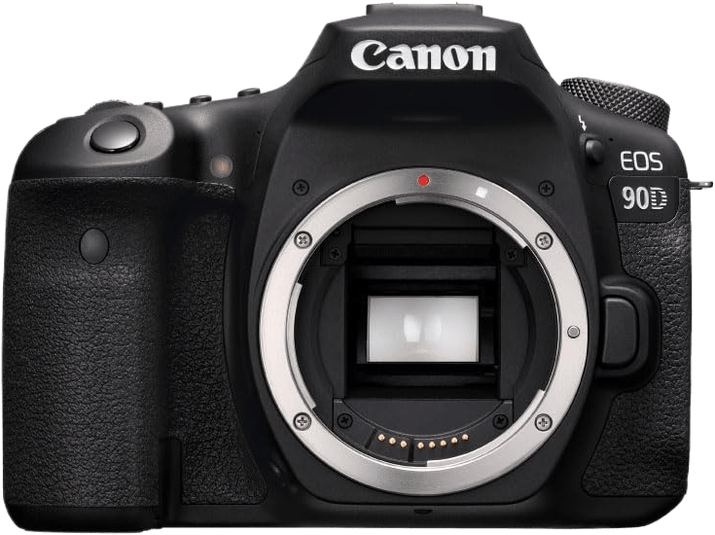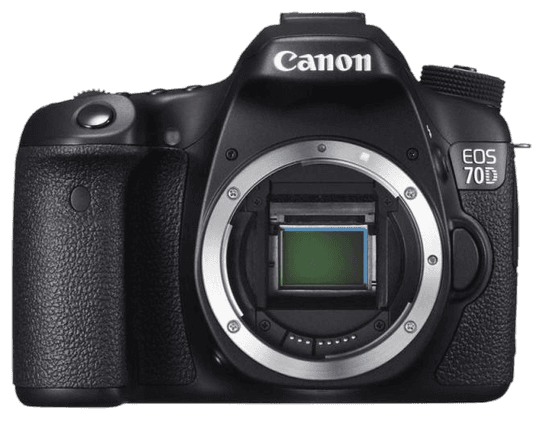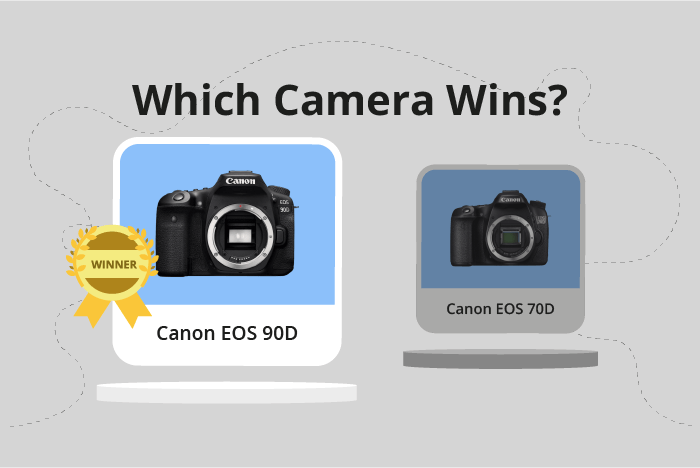Canon EOS 90D vs EOS 70D Comparison
Canon EOS 90D

Canon EOS 70D

The Canon EOS 90D outperforms its predecessor, the Canon EOS 70D, with a score of 67/100 compared to the 70D’s 60/100. Both cameras share the same DSLR type, launch price of $1199, and similar dimensions. However, the 90D, released in 2019, is notably lighter at 701g (1.55lbs) than the 70D, which weighs 755g (1.66lbs) and was released in 2013.
The 90D’s higher score reflects its better performance and more advanced features. Its reduced weight makes it more convenient for travel and extended use. On the other hand, the 70D still holds value as a reliable camera, especially for those on a budget or just starting in photography.
Taking these factors into account, the Canon EOS 90D is the clear winner for its improved performance and lighter weight, while the Canon EOS 70D remains a solid option for beginners and budget-conscious users.
Canon EOS 90D vs EOS 70D Overview and Optics
The Canon EOS 90D outperforms the Canon EOS 70D in optics with a score of 62/100 compared to the 70D’s 58/100. Both cameras share similar specifications, including CMOS sensors, APS-C sensor size, Canon EF/EF-S lens mounts, and lack of image stabilization.
The EOS 90D has a clear advantage in megapixels and shooting speed, boasting 33 megapixels and a 10 fps shooting speed, while the EOS 70D has 20.2 megapixels and a 7 fps shooting speed. The 90D also benefits from a more advanced processor, the Digic 8, which enhances its overall performance and image quality.
However, the EOS 70D surpasses the 90D in one aspect: its DXOMARK sensor score. With a score of 68, the 70D’s sensor performs better than the 90D’s sensor, which has a score of 58. This higher score means the 70D may produce better image quality in certain situations.
Despite the 70D’s advantage in sensor score, the 90D’s higher megapixel count, faster shooting speed, and upgraded processor make it the better option for those seeking improved optics. The 90D’s capabilities provide users with greater flexibility and performance when capturing images.
On the other hand, the 70D’s higher DXOMARK sensor score may appeal to those who prioritize image quality above all else. However, the 90D’s overall advantages in other areas of optics make it the superior choice for most photographers.
Canon EOS 90D vs EOS 70D Video Performance
The Canon EOS 90D outperforms the Canon EOS 70D in video capabilities, with a video score of 91/100 compared to the 70D’s 43/100. Both cameras share some common specifications, such as Canon’s Dual Pixel CMOS AF system for smooth and accurate autofocus during video recording. Additionally, both cameras offer a microphone input for improved audio quality.
The EOS 90D’s superiority in video capabilities stems from its higher maximum video resolution of 4K (3840 x 2160) compared to the 70D’s Full HD (1920 x 1080) resolution. This allows for more detailed and higher-quality video footage with the 90D. Furthermore, the 90D offers a maximum video frame rate of 120fps, enabling slow-motion recording, while the 70D is limited to 30fps. The 90D also includes built-in time-lapse functionality, a feature absent in the 70D.
The EOS 70D, however, does have a few advantages over the 90D. Its lower resolution and frame rate requirements result in smaller file sizes and less demanding storage needs. This can be beneficial for users who prioritize storage space and ease of file management.
Taking all factors into consideration, the Canon EOS 90D is the clear winner in terms of video capabilities. Its 4K resolution, higher frame rate, and built-in time-lapse functionality provide more versatile and higher-quality video recording options. While the EOS 70D may have some advantages in terms of file size and storage requirements, these benefits are outweighed by the 90D’s superior video performance. As a result, the Canon EOS 90D is the better choice for those prioritizing video capabilities in their camera selection.
Canon EOS 90D vs EOS 70D Features and Benefits
The Canon EOS 90D outperforms the Canon EOS 70D with a feature score of 83/100 compared to 70/100. Both cameras share some common specifications, such as a 3-inch screen size, 1040000 dots screen resolution, touchscreen capability, flip screen, GPS unavailability, and WIFI functionality.
The EOS 90D takes the lead with its Bluetooth connectivity, which the EOS 70D lacks. This feature allows users to easily connect the camera to other devices, such as smartphones, tablets, and computers, for quick and seamless image transfer. Consequently, the EOS 90D offers a more convenient and user-friendly experience.
On the other hand, the EOS 70D does not have any significant advantages over the EOS 90D in terms of features. Both cameras have the same screen size and resolution, which means they offer similar visual experiences when composing and reviewing images. Additionally, both cameras lack GPS functionality, which could be helpful for geotagging images.
To sum up, the Canon EOS 90D is the superior camera in terms of features, primarily due to its Bluetooth connectivity. This advantage provides users with a more convenient and efficient way to transfer images between devices. While the EOS 70D shares many similar specifications with the EOS 90D, it does not offer any distinct advantages. Therefore, the Canon EOS 90D is the better choice for those seeking a camera with advanced features and a seamless user experience.
Canon EOS 90D vs EOS 70D Storage and Battery
The Canon EOS 90D outperforms the Canon EOS 70D in storage and battery with a score of 48/100, compared to the 70D’s score of 37/100. Both cameras share the same number of memory card slots (1) and accept SD, SDHC, and SDXC memory cards. However, the 90D is compatible with UHS-II cards, providing faster read and write speeds.
The 90D has a significant advantage in battery life, offering 1300 shots per charge compared to the 70D’s 920 shots. The 90D uses the LP-E6N battery, while the 70D uses the LP-E6 battery. Both cameras lack USB charging capabilities.
Despite the 90D’s higher score, the 70D is still a reliable camera for storage and battery. Its only disadvantage is the shorter battery life and lack of UHS-II compatibility. The 90D’s longer battery life and faster memory card compatibility make it the better choice for extended shooting sessions and quicker data transfers.
Alternatives to the Canon EOS 90D and EOS 70D
Are you still undecided about which camera is right for you? Have a look at these popular comparisons that feature the Canon EOS 90D or the Canon EOS 70D:

